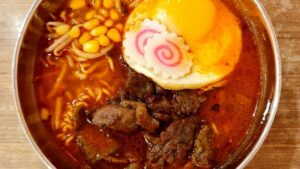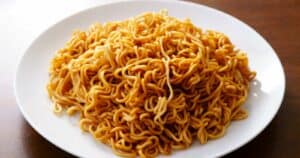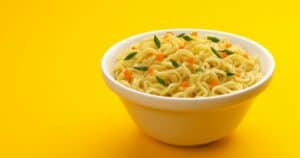The savory aroma rising from a steaming bowl of ramen noodle soup is undeniably tempting, but is drinking the leftover broth actually unhealthy?
Surprisingly, slurping down that tasty ramen water is not inherently harmful in moderation. However, the sodium-rich broth should be enjoyed as part of an overall balanced diet.
Coming up, we’ll explore whether it’s bad to drink noodle water by looking at the nutritional content of ramen broth. We’ll compare traditional homemade ramen versus instant packaged noodles. You’ll also find healthier ramen options and simple tips to cut sodium and calories in your favorite noodle dish.
Read on to get the full story on ramen noodle water and become an expert noodle consumer while keeping your health intact. Let’s dive in!
The Alluring Aroma of Ramen Water
That savory aroma wafting up from a steaming bowl of ramen is undeniably appetizing. The flavorful broth beckons you to take a sip. But is giving into the temptation actually unhealthy?
Surprisingly, slurping down that tasty ramen broth is not inherently harmful – as long as you enjoy it hot and fresh. Allowing it to cool can decrease the flavor and health merits. Even chilled instant ramen won’t harm you, but it may lack the satisfying taste and warmth you long for.
However, ramen noodles themselves are high in calories, fat, and sodium. Moderation is key to staying healthy if ramen is your go-to food.
Coming up, we’ll explore the nutrition in traditional and instant ramen. We’ll also give healthier options to please your noodle fix. Read on to become an expert ramen eater while keeping your wellbeing intact.
What Exactly is in Ramen Water?
Ramen broth contains a mix of ingredients that shape its nutritional makeup. Made with meat and heightened with soy sauce or miso, the soup consists of seasonings too. Think ginger, black pepper, garlic powder, onion powder, sesame oil, Worcestershire sauce, sriracha, and more.
The nutrition in ramen water fluctuates based on the components used and cooking technique.
Drinking ramen broth alone is not a balanced meal. It’s typically high in sodium without adequate nutrients. But here’s what one serving of ramen water contains:
- Sodium: Depending on brand and broth type, a single serving can have up to 50% of the recommended daily sodium intake.
- Protein: Meat-based ramen broth may contain up to 5 grams of protein per serving.
- Vitamins and minerals: Ramen water might have small vitamin and mineral amounts based on the ingredients used.
While drinking straight ramen broth can be tasty and convenient, remember it does not provide balanced nutrition on its own. To get the full benefits of the nutrients in the soup, enjoy it as part of a complete meal.
How Much Sodium is Too Much in Ramen Broth?
The sodium content in ramen broth varies, but keeping it under the recommended 2,300 milligram daily cap is vital for good health. Too much sodium can result in high blood pressure, heart disease, and stroke.
Here are factors affecting the sodium content in ramen broth:
- Ingredients: Ramen broth often contains soy sauce or miso, both high in sodium. Other seasonings like low-sodium ramen
spice , ginger, black pepper, garlic powder, onion powder, sesame oil, Worcestershire sauce, and sriracha also contribute sodium. - Cooking method: The cooking process and amount of salt added when making the broth significantly impacts its sodium content.
Here are ways to reduce the sodium content in ramen broth:
- Use low-sodium or no-salt-added broth or bouillon cubes.
- Limit the soy sauce and miso amounts in recipes.
- Opt for low-sodium seasoning swaps like soy sauce.
- Choose fresh flavors like ginger, garlic, and onion rather than pre-made sauces or powders with hidden sodium.
It’s vital to keep an eye on the sodium content in ramen broth and eat it in moderation as part of a nutritious diet. Adjusting the recipe as needed helps you enjoy ramen without sacrificing your health.
Traditional Ramen vs. Instant Ramen: Which is Healthier?
Looking at nutritional values, traditional ramen is typically healthier than instant ramen. Traditional ramen uses fresh ingredients, while instant ramen is a processed food high in sodium, calories, and unhealthy fats. However, some instant ramen brands provide low-sodium or organic options that may be better for you.
Traditional ramen:
- Uses fresh noodles, meat broth, and diverse toppings like sliced pork, nori, menma, and scallions, providing key nutrients.
- The broth may contain low-sodium spices and ingredients like ginger, black pepper, garlic powder, onion powder, sesame oil, and Worcestershire sauce.
- Nutrition can vary based on components and cooking method, allowing you to tailor it to your health needs.
Instant ramen:
- Contains dried noodles, a flavor packet, and additives like preservatives, artificial flavors, and colors, making it less nutritious.
- Often high in sodium, calories, and unhealthy fats, which can contribute to issues like high blood pressure, obesity, and heart disease.
- Lacks essential nutrients such as fiber, protein, vitamins, and minerals.
Here are tips to make instant ramen healthier:
- Choose low-sodium or organic instant ramen options.
- Add fresh veggies like spinach or kale to increase fiber and nutrients.
- Include protein sources like eggs or tofu.
- Only use part of the flavor packet, and season with low-sodium herbs or spices.
The Health Benefits Found in Ramen Broth
Ramen broth can be a nutritious and delicious dietary addition. The broth is typically made with meats and veggies and an array of seasonings that provide health perks. Here are some of the nutrients you’ll find in a bowl of ramen broth:
- Protein: Ramen broth often contains chicken or beef, giving you a good protein source to build and repair muscles.
- Vitamins: Veggies like garlic and onions used in the broth are rich in vitamins and minerals, including vitamin C, B6, and iron.
- Iodine: Toppings like nori can provide iodine, which is key for thyroid function and overall health.
- Fiber: While the broth itself does not offer much fiber, adding veggies like spinach or bok choy boosts your fiber intake.
While homemade ramen broth can be nutritious, it’s important to watch your sodium intake. Store-bought or processed broth can be high in sodium, causing issues like high blood pressure if you eat too much.
As with any food, it’s best to enjoy ramen broth moderately as part of a balanced diet.
Should You Drink Instant Ramen Broth?
Ramen broth contains tasty seasonings that provide health advantages plain water does not. It’s vital to store ramen noodles properly to avoid spoilage and foodborne illness.
Fresh ramen noodles keep for up to four days in the fridge, and instant ramen noodles stay good for two to three years if stored correctly.
Before eating expired instant ramen noodles, check for signs of spoilage like mold growth or soggy spots.
- Ramen water lacks flavor and nutrients compared to the broth.
- Ramen broth has seasonings like low-sodium ramen
spice , ginger, black pepper, and more. - Proper ramen noodle storage avoids foodborne illness.
- Fresh noodles last about four days in the fridge, while instant noodles keep for two to three years.
- Inspect expired instant noodles for mold or sogginess before eating.
Tips to Reduce Sodium and Calories in Your Ramen
You can make your ramen dish tastier and healthier by cutting sodium and calories. Try these simple tips:
- Use low-sodium swaps: Replace regular broth or bouillon with low-sodium kinds. Opt for low-sodium soy sauce or miso instead of normal varieties.
- Rinse the noodles: Wash noodles before cooking to remove excess salt.
- Load up on veggies: Boost nutrients and reduce calories by adding more veggies like spinach, mushrooms, and carrots.
- Pick lean proteins: Swap fatty meats like pork or beef for leaner options like chicken or tofu.
Adding these tricks to your ramen recipe lets you enjoy a flavorful, satisfying meal that’s lower in sodium and calories.
Healthy Ramen Alternatives to Satisfy Your Cravings
While ramen noodles can be high in sodium and calories, there are healthier options to please your noodle fix. Make simple swaps for a more nutritious ramen dish:
- Homemade ramen: Use whole wheat noodles, lean proteins, and plenty of fresh veggies.
- Whole wheat noodles: More fiber than regular ramen noodles.
- Lean proteins: Chicken, tofu, or seafood add protein without lots of fat.
- Vegetables: Spinach, mushrooms, carrots, and more boost nutrients and reduce calories.
- Low-sodium broth: Choose low-sodium broth or bouillon. Use low-sodium soy sauce or miso.
- Healthy noodle swaps: Try wonton or tofu shirataki noodles. They’re lower in sodium, fat, and carbs than ramen.
Choosing these healthier ramen picks can satisfy your cravings while sticking to a balanced, nutritious diet. Experiment to craft the perfect ramen dish for you.
In Summary
Ramen noodle water doesn’t have to be unhealthy. Consumed in moderation as part of a balanced meal, the savory broth can be a tasty part of your diet. Just be mindful of its sodium content, and opt for healthier homemade or low-sodium varieties. With a few easy swaps and added veggies, you can still enjoy ramen while maintaining your wellbeing.





